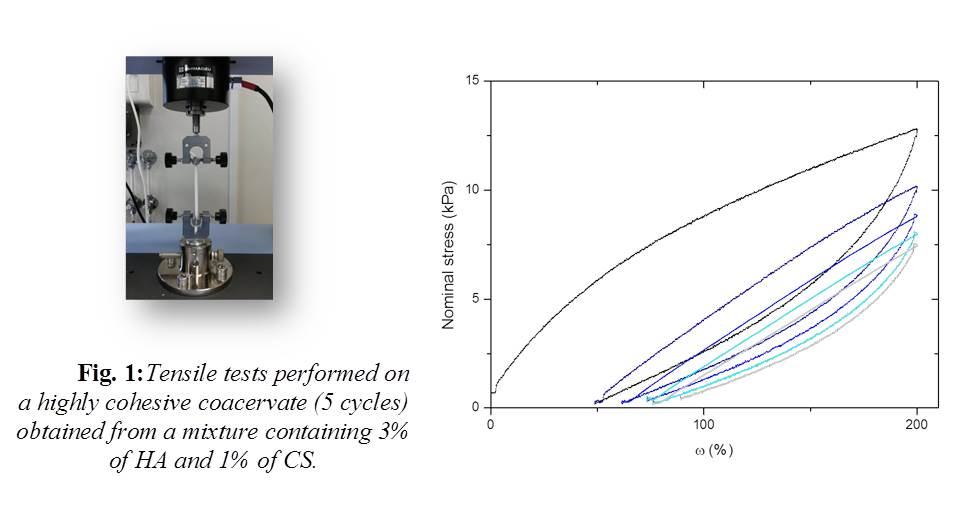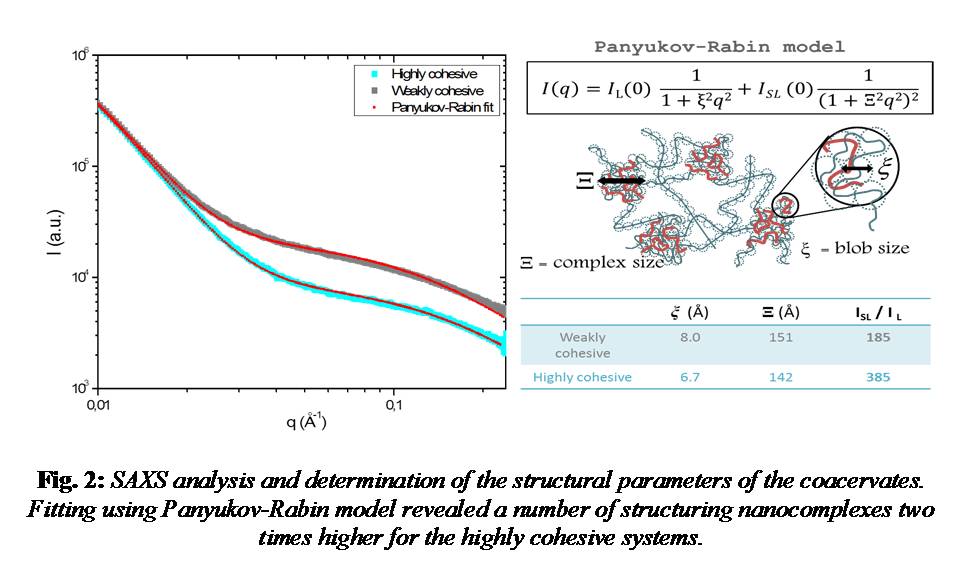Introduction: Hyaluronic acid (HA) is an anionic polysaccharide naturally present in the human body, such as in the skin, the cartilage and the vitreous humor. Chitosan (CS) is the only naturally occurring cationic polysaccharide obtained from the partial deacetylation of chitin. These two polysaccharides are known for their biocompatibility, bioactivity, and biodegradability.
In this project, we were able to form coacervates by controlled self-assembly via desalting of a soluble mixture of the two natural polyelectroytes thanks to a dialysis process[1]. Depending on the experimental conditions during the dialysis process, we obtained very different mechanical behaviors. These differences were investigated by SAXS and a first comprehension of these systems is reported.
Materials and Methods: HA was used as received from HTL (France) and has a molecular weight (Mw) around Mw = 1000 kg/mol. Chitosan was purchased from Mahtani chitosan Pvt. Ltd. (India). Its molecular weight is Mw = 150 kg/mol and the degree of acetylation (DA) is about 1 %. From this batch, chitosan samples having differing degrees of acetylation over 10 % were prepared by acetylation with acetic anhydride.
The solutions of CS and HA were first prepared separately in a 0.65 M solution of sodium chloride and then mixed. The mixture was then dialyzed against deionized water or, alternatively, against an acidic medium, which induced the assembly.
Rheological measurements were performed on a AR2000 rheometer using a 25 mm steel plate geometry in the linear viscoelastic domain.
Mechanical tests in the wet state were performed on a Shimadzu AG-10kNX Universal tester machine equipped with a 100 N load cell.
Small Angle X-ray Scattering experiments were carried out at ESRF (France) and gave us access to q range from 0.02 Å-1 to 0.35 Å-1.
Results and Discussion: We determined that the polyelectrolyte complexes formation almost always led to coacervate systems resulting from syneresis. The properties of such coacervates were highly dependent on the preparation method.
When dialysis was carried out against deionized water, coacervates exhibited weakly cohesive and gel-like behavior. The rheological measurements revealed that the storage modulus G’ was higher than the loss modulus G’’, with G’ and G” curves parallel in the whole studied range of frequencies.
When dialysis was carried out against an acidic medium at pH around 2.5, highly cohesive coacervates were obtained (Fig. 1), exhibiting outstanding hyperelastic properties.

This was due to conformational rearrangements of HA at pH aroud 2.5 providing more flexibility[2]. With SAXS, using a Panyukov-Rabin model, we could acquire an insight of the internal structuration of the coacervates. It appeared that the high cohesiveness was due to larger amounts of structuring nanocomplexes than for the systems dialyzed against water (Fig. 2).

Conclusions: We obtained biomaterials formed by the self-assembly of two natural polymers. We showed that we can tailor the mechanical properties of the hydrogels by varying the formulation pathway. We can thus induced conformational rearrangements and controlled the polyelectrolyte complexation to form hydrogels with varying characteristics. The study of the nanostructure by SAXS was essential to point out the main differences in mechanical behavior. These materials have a wide potential for biomedical applications.
Cyrill Rochas from ESRF, France for his assistance during the SAXS experiments; Agnès Crepet from IMP@Lyon1, France for his help for the characterization of HA and CS; The ANRT - Cifre program for the financial support
References:
[1] Costalat, M., David, L. & Delair, T. Reversible controlled assembly of chitosan and dextran sulfate: A new method for nanoparticle elaboration. Carbohydr. Polym.102, 717–726 (2014).
[2] Gatej, I., Popa, M. & Rinaudo, M. Role of the pH on Hyaluronan Behavior in Aqueous Solution. Biomacromolecules6, 61–67 (2005)